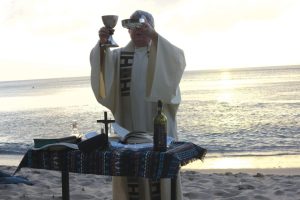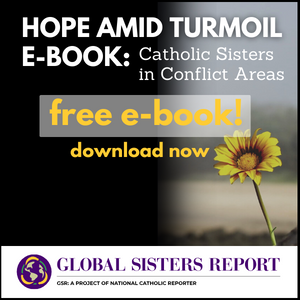 A Polish Catholic would be a basket case without this annual blessing of Easter goodies.
A Polish Catholic would be a basket case without this annual blessing of Easter goodies.
My mother is 100 percent polish (with a maiden name ending in “-ski” to prove it). When I was little she would tell me about her annual Holy Saturday morning church visit with our grandmother for the blessing of the Easter baskets. Parishioners from St. Casimir Parish in Hammond, Indiana would bring baskets full of samplings from their planned Easter dinner: spicy Polish sausage, sweet anise bread, hardboiled eggs, a sugar or butter lamb, horseradish mixed with beets, and other sweetbreads.
Several years ago, while home for Easter, I decided to go with my mom to her parish for the blessing of the baskets. Thirty people gathered in the church, placing their baskets at the end of the pew in the aisle. Heavenly smells filled the church, the aroma of fresh bread mingling with the salty ham and pungent horseradish. People—many of them strangers to one another until now—chatted animatedly in low voices, discussing their elderly Polish relatives and towns of origin. They peeked in each other’s baskets, admiring the butter lambs and inhaling the scent of the Polish sausages, swapping stories of driving two and a half hours to delis and groceries in Chicago’s Polish neighborhoods.
Before long an elderly, smiling priest (who happened to be Polish-born) emerged from the sacristy with a little bowl of holy water. He prayed a three-part blessing in Polish, using a branch of fresh greenery to sprinkle each basket with holy water. I couldn’t understand a word he said, but somehow hearing the guttural, consonant-rich sounds of a foreign language made the whole experience seem more authentic. I later learned that the blessing specifically addresses the various contents of the basket, with special prayers for the meats, eggs, cakes, and breads. The ceremony is brief, perhaps only 10 or 15 minutes. After the final blessing, we all picked up our baskets, wished each other a “Happy Easter,” and went on our way.
The custom of the blessing of the Easter baskets, called swieconka, came from Polish immigrants. While in a few older or rural communities the priest visits homes to bless the Easter foods, the vast majority of blessings take place in parishes. Poles and Polish Americans take special pride in preparing a decorative and tasteful basket with pretty linens. One of the special joys of the blessing ceremony, in addition to celebrating shared heritage, is observing the beautiful foods and creations of other parishioners.
Though you wouldn’t necessarily notice it at first glance, Easter’s Christian significance is symbolized in the food brought to church for the blessing: Colored hardboiled eggs symbolize new life, for example; and a sugar or butter lamb represents Christ, the Lamb of God. The breads represent the Bread of Life, who died and rose for the life of the world. The meats and the decadent cakes—including a tall decorative cake called babka, often topped with a cross or a fish—represent the hearty, rich foods people traditionally abstained from during six weeks of Lenten fasting. The small portions represent the feast that will be shared by family and friends at Easter Sunday brunch or supper.
The 18th-century french gastro-nome and writer Jean Anthelme Brillat-Savarin once said, “Tell me what you eat, and I will tell you what you are.” I was reminded of these words as I took in the sights, smells, and smiles that Holy Saturday morning. What we eat says so much about who we are, and the preparation of a meal is one of the most heartfelt and honest forms of self-expression. That is why there was such a palpable sense of kinship among those who discovered their shared heritage through this simple blessing prayer. The carefully prepared baskets sparked ethnic pride in a delightful (and, as we would later discover, delicious) way.
Thanks to its simplicity and wide appeal, the annual Easter basket blessing has caught on in many parishes, even in those without a significant Polish population. I like knowing that, for many Easters to come, I’ll be able to carry on a tradition that people like my great-grandparents brought to this country.
This article appeared in the April 2006 issue of U.S. Catholic (Vol. 71, No. 4, page 48).














Add comment